CU Denver graduate students tackle walkability issues in northeast Denver
For years, we have partnered with urban planning graduate students at the University of Colorado Denver to perform walkability assessments of various Denver neighborhoods. In 2017, students were tasked with evaluating the walkability of the Montbello neighborhood in northeast Denver. These assessments included analyzing the existing conditions in Montbello by performing on-site audits using the WALKscope tool, researching demographic data for their study area, and interviewing local residents about their walking habits, challenges, and needs.
The students were then asked to identify “walkability gaps” based on this information and propose possible infrastructure improvements and policy changes to the pedestrian environment in their final reports. The entire project study area was bordered by 56thAvenue to the north, Peoria Street to the west, Chambers Road to the east, and I-70 and 40thAvenue to the south. Students were assigned to a census tract along either the Peoria Street or Chambers Road corridors.

The class, led by professor Ken Schroeppel, recently completed their final reports and presented their findings and recommendations to neighborhood community members interested in making Montbello a safe and convenient place to walk. The students identified a number of pedestrian infrastructure challenges, including subpar rollover curb sidewalks throughout the neighborhood and a serious lack of safe crossings along Montbello’s wide roads. Vehicle speeds, a lack of shade trees, poorly maintained sidewalks, and few destinations within walking distance of residential areas were also identified as barriers to walkability in Montbello.
In order to address these issues, the students presented a number of ideas for improving the pedestrian environment. They recommended policy changes such as rezoning to allow for the types of walkable developments that serve neighborhood needs, especially local grocery stores, cultural destinations, and community spaces. They also recommended a number of infrastructure changes, including the widening of substandard sidewalks, construction of sidewalks where they are missing, road diets to reduce vehicle speeds, and painted crosswalks that prioritize pedestrians.
These transportation and infrastructure challenges make walking or biking in general a dangerous option, and that’s certainly true for getting to school as well. According to the CU Denver student reports, almost 40 percent of Montbello residents are under the age of 18. Adding or improving sidewalks, crossings, and bicycle lanes around schools, parks, recreation centers, and libraries would go a long way in improving the quality of life for Montbello’s youngest residents.

